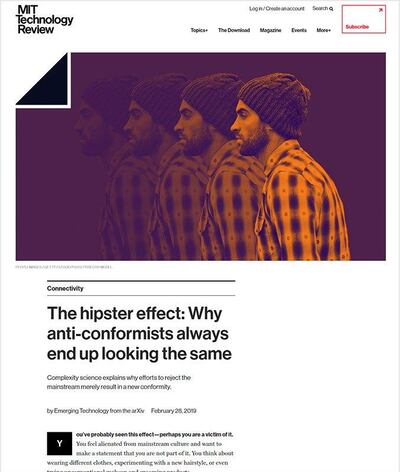The term "hipster" has apparently become so loaded that a model has accused a website of slander for using a stock image of him to illustrate an article titled "The hipster effect: why anti-conformists always end up looking the same".
But in a delicious twist, it later transpired that the photograph was not, in fact, of the model who complained – proof, perhaps, that hipsters really do all look the same.
The whole hilarious episode began when the MIT Technology Review website published an article seeking to explain why "efforts to reject the mainstream merely result in a new conformity". This article was accompanied by a photograph of a man with a beard, wearing a checked shirt and a beanie. So far, so normal.

But the editor of MIT Technology Review, Gideon Lichfield, then received an email from the model in the photograph. "You used a heavily edited Getty image of me for your recent bit of clickbait about why hipsters all look the same," the email read. "It's a poorly written and insulting article, and – somewhat ironically – about five years too late to be as desperately relevant as it is attempting to be, by using a tired cultural trope to try to spruce up an otherwise disturbing study."
Lichfield, who told the story in a series of tweets, checked Getty Images' terms and conditions to see if his publication had broken the law by referring to the man as a hipster.
“The image does have restrictions – eg, if you use it ‘in connection with a subject that would be unflattering or unduly controversial to a reasonable person (for example, sexually transmitted diseases)’, you should say that the person in it is a model,” explained Lichfield. “We weren’t implying that the model had an STD, only that he was a hipster. We didn't think this met the definition of ‘unflattering or unduly controversial’.”

Lichfield and his team debated whether to change the picture, but decided to contact the image library first.
“Getty looked in their archive for the model release. And came back to us with the surprising news: the model's name wasn't the name of our angry hipster-hater,” he wrote on Twitter.
“In other words, the guy who'd threatened to sue us for misusing his image wasn't the one in the photo. He'd misidentified himself. All of which just proves the story we ran: hipsters look so much alike that they can’t even tell themselves apart from each other.”
On hearing this news, the model emailed MIT Technology Review to say, "Wow, I stand corrected."
A few days ago we ran a piece in @techreview about some research purporting to explain the "hipster effect"—the fact that nonconformists often end up nonconforming in the same way. We used a stock Getty photo of a hipster-ish-looking man. https://t.co/8LB6qLSmgS
— Gideon Lichfield (@glichfield) March 6, 2019






